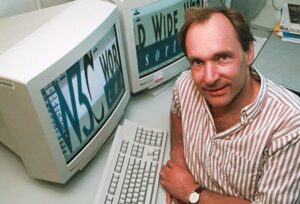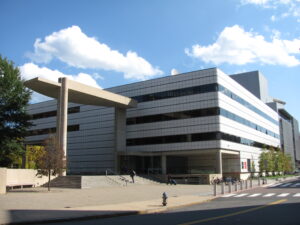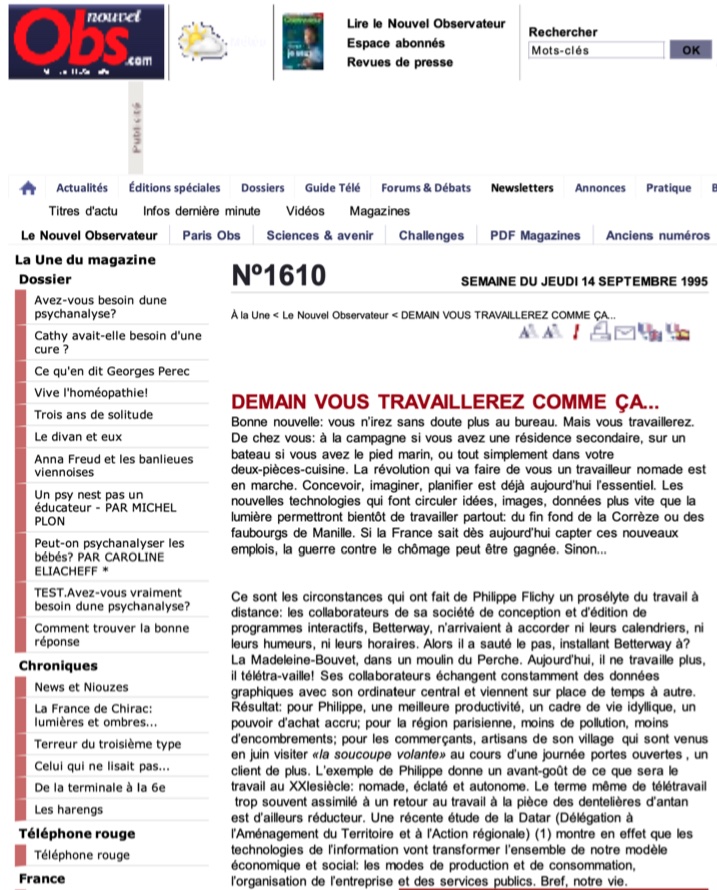Looking back into the future with The Electronic Barn of the 90’s experience. An idea to lower our carbon footprint and decrease our commute time while maintaining workplace interaction and boosting creativity.
Please let me invite you to travel back in time with me to just a year after Berners-Lee created the Internet that we know today, the year was 1992. I was leading “Better Way” a company I started in 1988 in Paris, France. As we were trying to find the right balance between the employees’ experience at work while easing their commute time around Paris, we ended up progressively moving further away from the center of the city to its distant suburbs each time we chose a new location. By then, our office was located in Rambouillet (45 kilometers southwest of the capital) next to the train station with a direct connection to one of Paris’ central train station, there were still many discussions about commuting, as much as, we all loved the space we were in.

Back when I was a student in Boston, I had been exposed to the concept of teleworking which the MIT MediaLab was working on. Along with some friends, the work done in this new laboratory sparked my imagination on the notion of building an “electronic barn”; a place in the countryside with all the attributes of the latest office technologies.
1992 was the year to build an “electronic barn” for me! I had just moved to a house on the opposite side of Paris from Rambouillet, in the middle of the countryside and had access to an abandoned barn. The idea of renovating it and securing ISDN lines to connect it to the world became a reality. Luckily at that time France Telecom still had a telecommunications monopoly in France and had to provide their service on all of the French territory at no extra installation cost. As we had carpenters installing windows, doors and an elevated floor; ISDN lines were pulled in and aggregated to get more bandwidth.


As we moved the office to this remote location, each employee could work from home and decide to visit the barn whenever they deemed necessary. Some decided to move outside of Paris, others, still living in Paris, would meet at a café to sync up once in a while. Once a month, we would all meet in Paris for an afternoon of work followed by an evening organized by one of the team members. It would consist of choosing a restaurant where we would have dinner as well as a “cultural” activity before or after the meal we shared. This allowed each of us to discover some of the others’ interests and taste in life and therefore better function as a team.

The concept was so new, I had even been mentioned in a book written by a journalist and invited on a famous national TV show to present my story. We kept the barn as one large open space with a technical area which had apparent brick ceiling to visually separate it, one production area, one admin area and a very cozy coach area with bookshelves filled with books and magazines inspired by the Sony R&D lab I had visited the previous year in Tokyo. This was during a cooperation trip between the French and the Japanese Ministry of Industry. It was very pleasing to the eye with all the ceiling metal beams painted in bright red and the walls in white. We kept the old 19th century pulleys on one side of the wall in stark contrast with all of the computers siting under or on top of the desks.
The company was developing multimedia content and had to create a heterogeneous network (DEC, Sun, PC, Mac) to support these efforts. At that time, Windows 3.11 had just been released and was using Microsoft NetBUI proprietary network protocol. As Microsoft released a TCP/IP layer, we had been able to source a third-party driver to emulate Xwindow terminals to use a PC as a Unix terminal; replacing very expensive dedicated hardware with much more affordable PCs. It became another activity for the company which already was known for the development of CD-ROM.
Without proper remote connection, it was not possible to give the distant team members access to all this technology. The ISDN lines with their 64Kb rates where all we had available at that time and it looked great compared to the 300 bauds modem I had when I was in university! Yet it proved slow and limiting at times for some of the developments we were working on. We resorted to the exchange of Bernoulli Box drives and later Zip drives to complement the telecommunication capabilities we had.

Developing multimedia content at the turn of the last century doesn’t resemble much of what is available today and various talents such as graphic artists and programmers had to work hard to understand each other. Some were artists who could create vibrant icons with only 16 colors while some were math geniuses optimizing the execution speed of the programs to run on slow and linear CD-ROMs*. Once the physical cues between two people are gone and you can only speak via a telephone line, understanding each other can become even more of a challenge. Thanks to the clever use of remote desktop that just came out and a lot of patience to wait for the screens to load the team was able to interact and come up with great results. They would be able to point to a part of the screen and discuss, alas, each in their own terms the matter at hand to come up with a mutual understanding more often than not.

Looking back at these epic days, what have we achieved?
From a quality-of-life perspective for the team, it was what they were aspiring for. Certainly, the computer towers and the video monitors of the time were more invasive than todays’ laptops, but we helped everyone to think of a workspace they could hide when they were not working. More importantly for them, they could live where they wanted and use the gained commute time for other activities.
From a work efficiency stand point, while the telecommunications were considerably slowing down the exchanges it also brought a sort of Zen inspired atmosphere. For starters, people learned to prepare for a call which somehow allowed them to plan for the disparity of their respective backgrounds. There were times of high frustration especially when we were nearing a deadline. Sometimes one would resort to visiting the barn for a couple of days at a time in order to speed up the last efforts to deliver a project on time. Secondly, as we were a small team everyone was very responsible and only a phone call away when needed.
From a marketing perspective, the teleworking organization was a great success. Customers and partners were looking forward to coming to visit us. I still remember a rainy winter day when some senior executives from Louis Vuitton decided to come and see for themselves what kind of aliens we were. The Normandy region in the winter can be pitiful, cold, and humid. I still have the image of our visitors with their stylish shoes getting ruined as they stepped out of their luxurious car in the muddy yard. Fortunately, the unhappy faces of our guests magically lit up as soon as they entered our barn. We had created a magical space where technological creativity and artistic conception were in symbiose, it felt wonderful for the ones working there as much as for the visitors.

It took the 2020 COVID-19 pandemic, since the world has been forced to temporarily close down offices to resume the discussion and thoughts on this futuristic experience of that time period and the learnings from the early MediaLab research that had been initiated at the end of the last century. Visionary ideas of an era might very well become the reality of another. When leading the MediaLab, Nicholas Negroponte insisted on the notion of pods hosting workers of different companies (much like today’s incubators but with employees of large companies) close to the homes to ease the commute time of the employees and to maintain social interaction, but also to encourage cross pollination between employees of various corporations. With the COVID-19 confinement we have experienced the agreements of radically less commute and travel but the difficulty of staying at home. Will we take the next step to create work centers like the pods Nicholas Negroponte had envisioned? At least we have come to realize that teleworking is now much more accessible than at the turn of the century thanks to technology advancement. Building trust and team spirit remains essential and what we had accomplished a quarter century ago proves to still be of value today.
* CD ROM has been developed on the same linear format created for the CD Audio. The surface was optimized to store as much music as possible on it as when you play a song, one can anticipate the next bit of information to read to continue playing the song. If you store a book on a CD ROM you experience the same type of condition, but as soon as you want to follow hyperlinks or allow at any given point a user to select various options on a screen, you have to figure out where to place each bit of information the user can potentially access so it can be reached as fast as possible. Contrary to a hard drive the sectors are not aligned to go back and forth from the center of the disk to its outer side.

